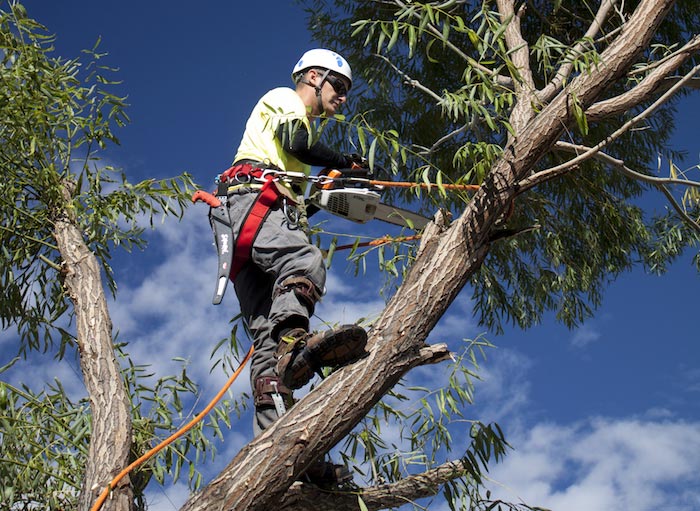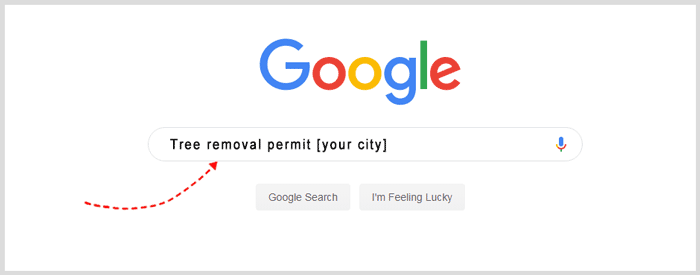The cost is contingent on the city of residence and the tree’s dimensions.
Most city governments have Tree Preservation Ordinances1 outlining the rules and regulations that surround tree removal and tree trimming.
As trees play a vital role in urban cities’ livability, their removal is regulated. In most cases, it is illegal to cut down a tree on your own property before first obtaining a permit.

What we cover
ToggleWhen is removing trees permitted?
In short when you apply for a permit to do so. Also when it is outlined in the tree ordinance you can remove it without a permit, such as when a tree is dead or dangerous.
Your city’s ordinance on tree removal will list specially regulated trees as either”
– Significant tree – If they are above a certain height or considered a perfect specimen
– Heritage tree – when believed to be of significant age.
Even applying for a permit won’t guarantee you can remove either of the above types of trees.
Do I require a tree cutting permit for any tree?
Not always, but in a lot of cases yes. Again it does depend on the regulations in your city about removing trees on private property, but to play it safe I would assume the answer is yes and endeavor to get a removal permit before starting work.
How do I apply for a tree removal permit?
Do a quick internet search for “tree removal permit [your city]”. In the search, a .pdf document should come up which you can download and fill out to get the process started.

Where can I find my cities tree ordinance?
We have links to most tree ordinances in the United States. Scroll down (or click here) to select your state, then your county.
Once on your county page, you will find a link to your specific city tree ordinance as well as a summary of the ordinance.
What about a hazardous trees?
In these cases, you will not need a permit. As the application process can take weeks, you need to go straight to the removal of the tree before it hurts someone. You will need to document the issue with the tree and it will need to be verified by a certified arborist.
This could occur after a storm when the tree develops a lean overnight, or maybe it was hit by lightning.
I also advise documenting the damage with photos just in case.




Do I need a tree removal permit for dead trees?
In most cases, you will not need a tree-cutting permit for dead trees. Just find a local arborist to do the job and away you go.
I have noticed the odd city (though very few) that does require you to inform the city’s arborist that you intend to remove a dead tree before carrying out the work. You will not need to apply for a permit first though.
In doubt, a local arborist in your city will soon tell you whether you are within your rights to remove a dead tree.
Do I need a permit for tree trimming?
In general no. Just as long as the tree is not a street tree and is on your property, the tree is not significant or heritage and you do not take more than 25% of the tree’s foliage.
Depending on the city there are other rules such as;
No hat-racking
No trimming palm trees above the horizon line
No spiking live trees
You will need to refer to your local tree ordinance for more information on the trimming rule, but in most cases, you will not require a permit.
Also, the trimming will need to be carried out by a certified arborist.
Why are trees on my property protected?
Trees are considered the property of the community, but just happen to be on your land.
They bring great benefits to all residents including cleaner air, reduced temperatures in summer, less soil erosion, promote birdlife, and a whole host of knock-on effects that benefit all.
If you didn’t need a permit to cut down a tree on your property, and there were no strict codes of practice, your local neighborhood would look drastically different, and so would your quality of life there.
Can I trim a street tree?
Trees on public land are generally out of bounds. You are only permitted to prune trees on your property. If there is a tree on public land that needs trimming or removal, please contact your city’s arborist to inform them of the issue and they will take action on your behalf.
Can I trim tree around utility lines without a permit?
In most cases, no tree permit is required. As it is a routine maintenance thing that is in the best interests of public safety, you are allowed to do so. Remember to use a qualified and licensed arborist for this work.
- Department of Environmental Conservation, (2014) Tree Ordinances – NYDEC. <https://dec.ny.gov/nature/forests-trees/urban-and-community-forestry/managing-your-community-forest/tree-ordinances> Accessed: 16-02-2024.




